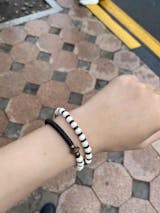Tibetan Mala Bracelets: Sacred Prayer Beads from the Himalayas
Tibetan mala bracelets – most commonly made with 108 prayer beads – are cherished as both meditation tools and meaningful Tibetan jewelry. Originating in ancient India and adopted into Himalayan Buddhist practice, the term mala even means “garland” in Sanskrit, symbolizing a continuous loop of sacred energy. Each handcrafted mala carries cultural heritage: it is worn or held in hand during meditation to count mantras, and its materials and design convey spiritual intention. In this way, a Tibetan mala bracelet blends mindful purpose with artistic tradition.

Historical and Spiritual Origins
Mala beads trace back to early Buddhist and Hindu practices. Originally, meditating sages used strings of beads to count recitations and keep focus. Over centuries, this practice spread to Tibet and the Himalayas. In Tibetan Buddhism, mala beads became an essential part of daily practice – worn by monks and lay practitioners alike. These prayer beads are deeply rooted in Himalayan culture, reflecting a legacy of meditation and devotion. For example, Tibetan jewelry (including malas) often incorporates local motifs and materials, making each piece a vessel of the region’s spiritual tradition.
The Sacred Significance of 108 Mala Beads
A traditional Tibetan mala contains 108 beads, a number rich in symbolism. In Buddhist teachings, 108 represents the wholeness of existence and the full cycle of life. It also corresponds to 108 defilements or distractions (such as ignorance, attachment and anger) that one seeks to overcome on the path to enlightenment. Chanting a mantra 108 times is believed to purify the mind and body, helping the practitioner stay focused and present. Thus, completing all 108 beads in a mala is considered a complete devotional cycle, a reminder of spiritual discipline and cosmic unity.

Materials and Symbolism of Tibetan Mala Beads
Tibetan malas are made from natural materials, each chosen for its sacred meaning and energetic quality. Common materials include seeds, wood, bones, and gemstones.
Bodhi Seeds: Beads from the Bodhi tree (under which the Buddha attained enlightenment) represent awakening. They symbolize the path to spiritual growth and are said to cultivate mindfulness, wisdom, and balance.
Yak Bone: Often derived from naturally deceased yaks, bone beads remind wearers of impermanence and compassion. Tibetan tradition values yak bone malas as a way to honor the yak’s role and to reflect on life’s transience.
Sandalwood: Aromatic sandalwood beads are prized for their soothing scent and grounding energy. They promote tranquility, spiritual awareness, and deeper meditation, helping to center the mind.
Red Agate: A variety of chalcedony, red agate is associated with passion, courage, and stability. It is believed to “light you back up,” cleansing negative energy and giving the wearer strength to move forward. Like other agates, it also fosters emotional balance and harmony.
Black Obsidian: This volcanic glass is a powerful grounding and protective stone. Obsidian malas are said to shield against negativity and bring mental clarity. The deep black beads serve as a mirror for insight, reflecting away confusion and anchoring your energy.
Gemstone Crystals: Many Tibetan malas incorporate stones like turquoise, amethyst, jade, or clear quartz. Each brings its vibration: for example, turquoise provides calm balance and protection, while amethyst encourages inner peace, intuition, and spiritual growth. These crystals complement the mala’s intention, enhancing meditation and emotional resilience.

How to Use Mala Beads for Meditation and Mindfulness
Mala beads are primarily used for mantra meditation and mindfulness practice. A common method is:
Start at the Guru Bead: Hold the mala so the larger “guru” bead (or tassel) hangs away from you. Begin with the first bead next to the guru bead, holding it between your thumb and forefinger. Recite your chosen mantra or prayer once.
Move Bead by Bead: After each recitation, use your thumb to roll to the next bead. Continue reciting the mantra at each bead, sliding one bead at a time under your finger.
This tactile counting keeps your focus anchored – the repetition and touch of each bead prevent the mind from wandering.
Complete a Circuit: Proceed around the entire loop of 108 beads. When you return to the guru bead, you have finished one full round. Many practitioners then pause, reflect on their intention, or continue in reverse for further rounds. Completing the cycle embodies dedication and mental centering.
Set Intentions: Beyond traditional mantras, you can use the mala to repeat personal affirmations or intentions. Each bead can mark a silent affirmation, effectively “charging” the mala with positive energy.
Whether for gratitude, compassion, or healing, repeating affirmations bead-by-bead aligns your thoughts with your goals.
By weaving prayer or focus into each bead, mala practice cultivates deep mindfulness. You stay present with each breath and mantra. Even wearing the mala can remind you to breathe deeply and stay centered throughout the day.

Spiritual Benefits of Wearing Tibetan Mala
Regular mala use and the stones themselves are said to bring spiritual benefits that support inner well-being:
Grounding: Using the mala during meditation brings you into the present moment. Beads like black obsidian and agate are known grounding stones. Their presence and weight can help anchor your energy, making you feel more centered and stable as you practice.
Protection: Many Tibetan beads are believed to ward off negative influences. For instance, obsidian and turquoise beads are thought to form a spiritual shield, deflecting harmful energy. Carrying a protective mala can give the wearer a sense of safety and strength in daily life.
Clarity: The gentle repetition of mantra with each bead naturally quiets mental clutter. Stones like clear quartz or obsidian enhance this effect by promoting mental clarity. Black obsidian, especially, is said to “bring clarity to the mind” by helping to release confusion. As you meditate with your mala, insights and focus can deepen.
Emotional Balance: The overall practice of mala meditation encourages emotional equilibrium. In addition, soothing materials (e.g. agate, sandalwood or rosewood) help stabilize emotions and relieve stress. Over time, repeating affirmations and mantra with the mala can foster inner calm, peace and a balanced perspective on challenges.
Choosing Your Tibetan Mala Bracelet
When selecting a mala bracelet, follow your intuition and intentions. Consider which materials resonate with you. Think about the mantra or goal you wish to focus on, and let that guide your choice of beads and colors. Above all, trust the mala that feels right in your hand and heart. If you seek authenticity and mindful design, explore our collection of Tibetan mala bracelets. Each of our bracelets is made by skilled artisans using genuine, natural materials. Whether you wear it for meditation, mantra practice or simply as a reminder of your spiritual path, a Tibetan mala bracelet can bring grounding, clarity and purpose to your life.
Related Articles:
Explore Different Types of Mala Beads
108 Mala Beads: The Main Accessories and Their Functions
What Are Mala Beads Use For and Why Are There 108 Beads on a Mala




































